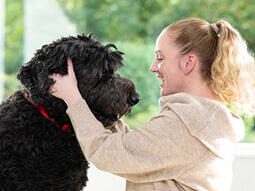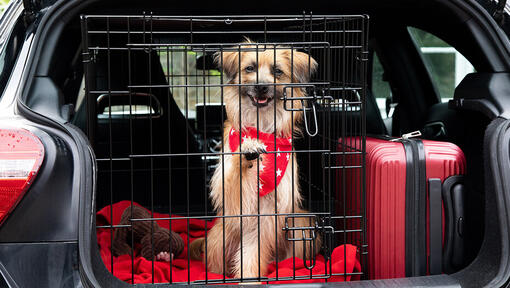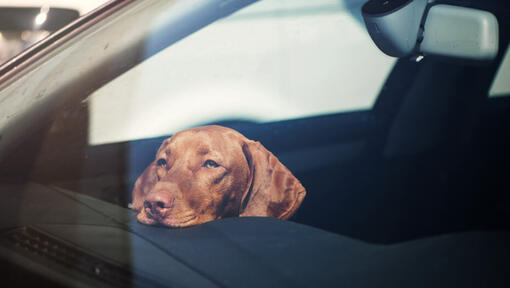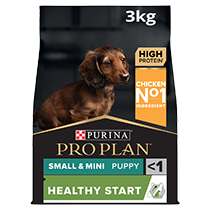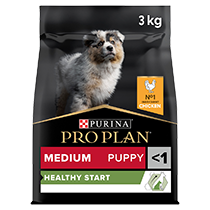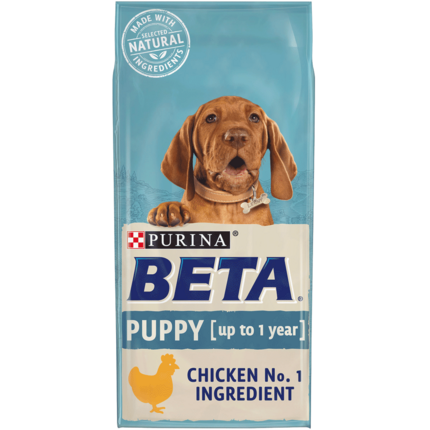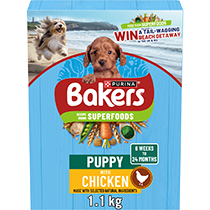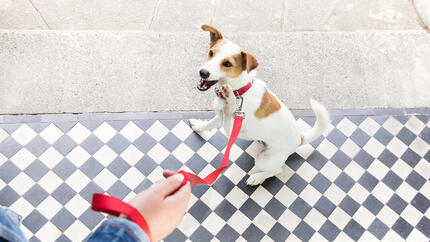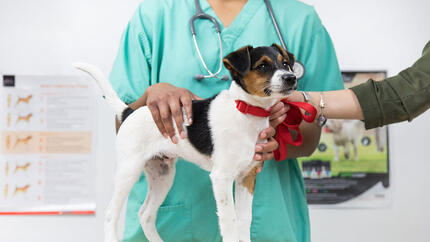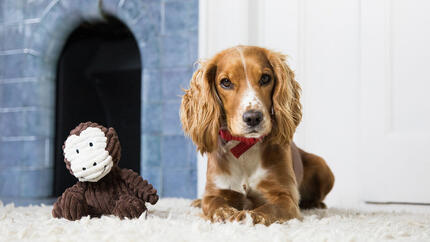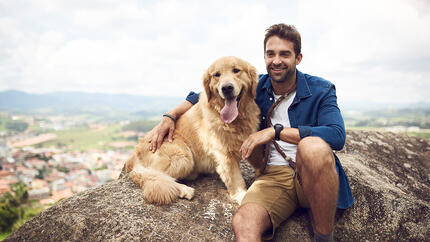

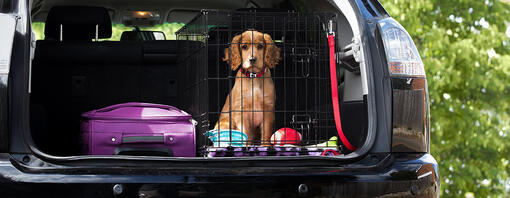
Turn your new puppy into an excellent travel companion.
You’ve got a new pup and you can’t wait to get out and start exploring the world together. We know the feeling! But before you start planning that amazing road trip (or even getting ready to drive to the vet’s), you have to remember that a car can be a very strange thing to a puppy. The closed space, the car movement and even the engine sound can trigger alarm bells for a puppy not used to travelling. But there are a few things you can do to make car trips easier for your pup and a lot more fun for you both. ! Here are the basics of car travelling for puppies.
Can Puppies Travel in The Car?
Yes, puppies can travel in cars – and for most, it is a key part of their lives – whether to get to great walking spots or to get the the vets but different dogs will view their first few car journeys very differently.
While some puppies bound in and out of cars without a care in the world, others find their initial car travel experiences a little more nerve-wracking. Thankfully, there are many things you can do to help your puppy feel more comfortable and start to enjoy their car journeys.
How To Train Your Puppy to Ride in the Car
When taking your dog in a car the secret is to make them feel safe and relaxed. The more relaxed and happy they are, the more comfortable and less stressed they’ll be. As with so many things with dogs, the sooner they experience car travel, the better. Many breeders will have already included car journeys as part of their puppies’ early socialisation experiences so your pup might already have a head start.
For more useful tips and guides on puppy training, read our helpful guide.
Where you decide you are going to want your puppy to travel will depend on your car and on the size of your dog. Wherever you choose, it has to be somewhere that they can be secure, be safe in the case of an accident or incident (so prevent injury to themselves and also to you), be comfortable, and not cause you a distraction when driving, The safest place is behind the back seats in a purpose designed dog crate. This can be lined with veterinary bedding to be a comfortable traveling place for your dog. If however you have a small car with no space to do this, a crate in the passenger footwell can be an option.
Start with them sitting in a stationary car. Give them plenty of time to have a sniff around the area they will be traveling in – and give them a treat or even feed them their dinner there. You want them to look on this space as a place where good things happen.
Starting the engine
Once they are relaxed and comfortable you can start the engine. It can be helpful to have someone with you to do all the ‘car things’ while you can sit with your puppy and give them treats/a chew or just make sure they are relaxed and happy.
Once they’re happy, you can move on to the next step.
Drive together to the end of the road and back. Again, it can be easier if you have someone else to drive. Be enthusiastic yourself – and give them a treat and reassure them so they look on this as a great experience.
Wherever you want your puppy to travel in the car, make sure it isn’t slippery (so no bedding that can scrunch up as you drive round corners) and if the crate has bars/mesh floor, use lots of padding. If you have to travel with your dog on the seat, get seat covers that aren’t slippery.
Assuming all goes well, you simply go on longer or more frequent trips as your puppy’s confidence grows. In your early journeys, always go somewhere enjoyable – like for a walk – so car travel is associated with positive outcomes.
How To Keep Your Dog Safe in the Car?
Dog car safety isn’t just about keeping your puppy protected; it’s about taking care of the driver and passengers too.
Take time to train your puppy to be calm and quiet in the car so they don’t distract the driver or cause a nuisance to other people in the car.
Use a crate or a dog barrier
If your puppy is traveling behind the back seats of in the foot well use a secure crate to keep them safely contained.
If this isn’t possible and your only option is to have your puppy sitting on a car seat, you can still get soft crates that you can secure using the seatbelt.
Dogs – especially puppies – often travel better if they can’t see out of the windows – as other cars and lorries etc whizzing past can be really scary.
You can get harnesses for car travel so dogs can sit on the seats but they are not as safe and are really difficult for a squirmy puppy to get used to – and that can often become a distraction for you as a driver.
Don’t let your puppy travel in the car with the head out the window
If you have your puppy properly restrained in the car, this is not going to be an issue for you – and just as well! If they are in a harness on the seat however you might need to think about this. It might look like great fun but they could get an eye irritation or, worse, get injured by something you drive past. There’s also the risk that they could slip out of their harness and jump out of the window. It’s absolutely fine to open the window a little bit so your dog gets plenty of fresh air, and on hot days if you don’t have air con, you can use a window guard that lets you open the window more without allowing your dog the chance to jump out.
Checker the Weather Forecast in Case of Hot weather
Most vehicles now have air conditinoning that means you can keep the inside of the car cool. However this is designed to keep passengers cool and rarely the area behind the back seat. Even if you think your car’s air con is fantastic, sit in the area where your dog travels and see if it reaches there! If not, a fan can help as can shading the windows – but it might mean re-considering long journeys on hot days. Even with the greatest air con, a motorway traffic jam can see your car overheating in a fairly short time.
If the weather’s hot you can also buy shades that attach to the windows to prevent strong sunlight coming in. Both the window guards and the sunshades help for when you’re moving but without air con, and even with the windows down and the sunlight protected, cars can heat up very quickly. NEVER leave your dog in the car on warm or sunny days, even in the winter, as it can be fatal.
Include frequent breaks for long car journeys
If you’re going to be travelling with your dog over long distances, make a habit of stopping every couple of hours. You’ll probably both appreciate a toilet break, a drink of water and the chance to stretch your legs – just always ensure that your puppy is wearing their collar and ID in case they escape.
How Do I Stop My Dog from Being Anxious in The Car?
If your puppy gets worried in the car you can ask your vet about using synthetic pheromones which are available in different formats – including sprays you can use in the car The scents are believed to be similar to the reassuring pheromones that mum will have emitted naturally when they were a puppy, so it should calm them down and keep them relaxed for around four hours.
Also try to provide them with some kind of familiarity in the car to make them less stressed, such as a favourite toy or a rug that smells like home. This is especially helpful for young puppies.
It’s better however to spend more time teaching your puppy that the car is safe sp go right back to your early introductions.
How To Stop a Puppy from Getting Car Sick?
Car sickness in puppies is quite common although most dogs do grow out of it. This is something that is far better prevented as it does create a negative association with the car. Talk to your vet about potential medication – although some people swear by remedies such as ginger biscuits!
Go back to the very beginning of getting your puppy used to car travel – and just take the shortest of trips – even if just to the end of the drive and back at very low speed – so they can get used to the motion.
A car sick puppy is an unhappy puppy – and no one wants that – so if you need to go on a longer journey, don’t travel when they’ve got a full stomach. It’s best to wait for two to three hours after meal time before you travel as a precaution and give your dog a walk just before you set off so they’re more likely to relax and not need to go to the toilet. . If car sickness becomes a frequent problem, ask your vet for their advice.
Remember to be patient and aim for gradual progress. Soon your puppy will become familiar with the car and know what to expect when they hear the door shut and the engine running - a great journey with a travel companion they love and plenty of off-key sing-alongs.
Discover more useful guides for welcoming your new pup home and make sure you’ve got all the basics right from vaccinations to neutering and puppy microchipping.

